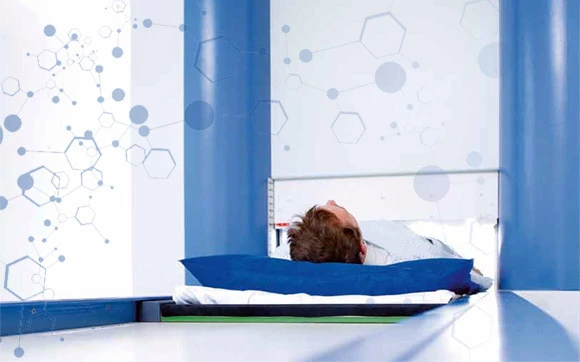Medical progress on the tiniest of scales
Adlershof companies combat cancer and other scourges of humanity
Companies like MagForce, Surflay Nanotec, and NanoBioAnalytics coat microcapsules, destroy cancerous growths with the aid of injected nanoparticles, and feed measuring probes to living cells at the Centre for Materials and Microsystems (CMM).
Lars Dähne is one of the protagonists. With twelve employees, the founder of Surflay Nanotech specialises in the layer by layer coating of tiny capsules and particles that make grains of sand look like veritable giants. Under charge changing processes, they deposit on surfaces in coatings only a few nanometers thick, even in nanopores. A nanometre is a billionth of a metre. This surface modification gives rise to all-new material properties: oil drops are distributed evenly in water, and highly sensitive lipids enveloping micrometre air bubbles become tear resistant.
Smuggle measuring probes directly into the relevant cells
The developers can integrate magnetic, fluorescent, or radioactive markers and even biomolecules in their coatings. These include e.g. DNA that as cargo in control particles could “calibrate” laboratory processes. “When DNA analysis is to identify pathogens, i.e. potential causes of disease, lab technicians must adhere precisely to the process parameters,” explained Dähne. Whether they have done so can be visualized with the defined release of coprocessed control DNA.Surfaces that promote the growth of tumours or certain body cells are also conceivable. They could smuggle measuring probes directly into the relevant cells. Dähne was quick to put it into perspective: “This is still pie in the sky for physiology.”
Yet the CMM’s neighbour NanoBio Analytics has succeeded in feeding coated particles functioning as microprobes to living cells and in measuring the forces these cells exert. This is interesting for cancer researchers because carcinogenic and healthy cells differ in their biomechanical behaviour. Once ensconced, the measuring particles can also determine the oxygen content and pH values in the cells.
Nanotherm method
The neighbouring MagForce AG has already progressed so far with its Nanotherm method that magnetic particles can be used to treat people. This method approved throughout the EU involves injecting these particles into malignant brain tumours and inducing oscillations by means of an alternating magnetic field. This causes the tumour tissue to heat up locally to a temperature as high as 70 °C. When treated in combination with radio- or chemotherapy, patients with a glioblastoma – leading to death in 97 percent of all cases – have considerably greater chances of survival. MagForce is currently announcing this method to oncologists and targeting approvals for other indications like pancreatic and prostate cancer.
By Peter Trechow for Adlershof Special
